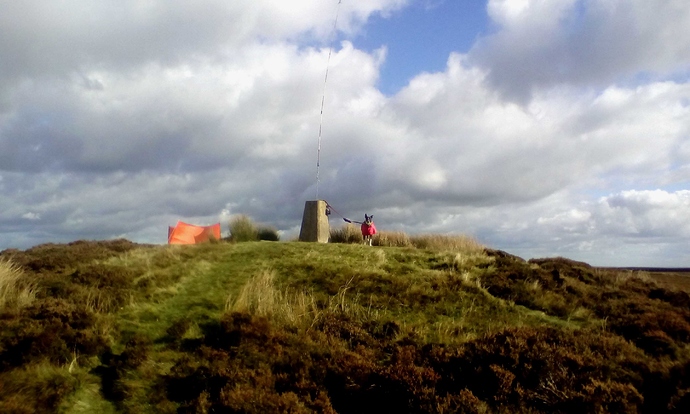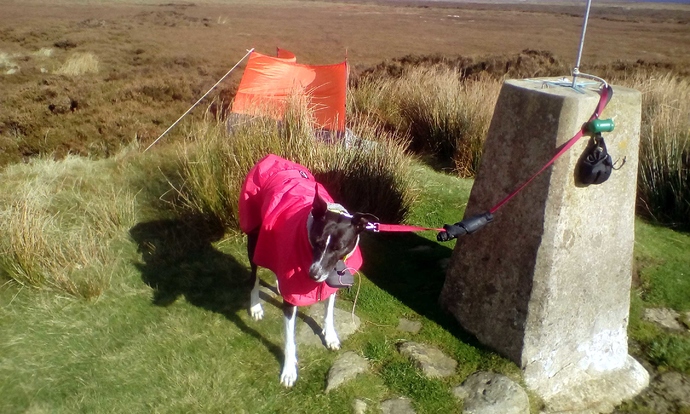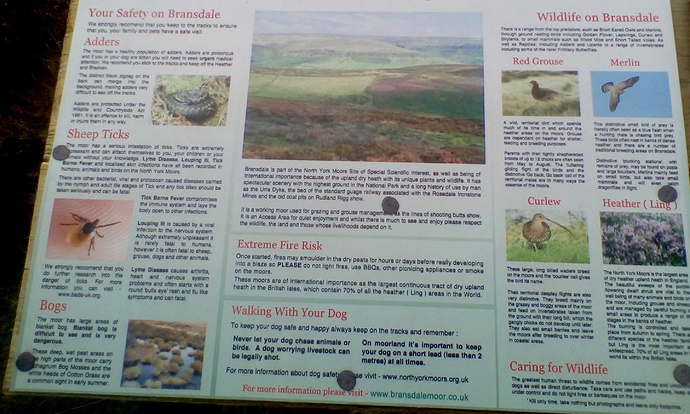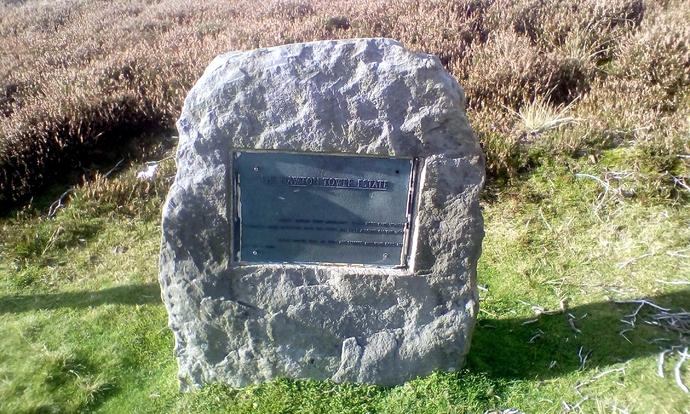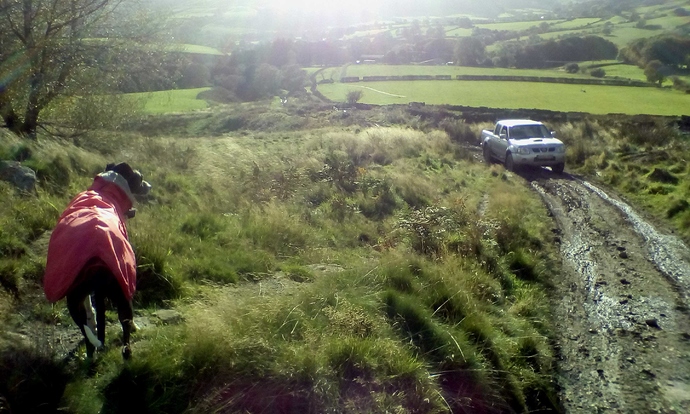Issue-1
Activation of URRA MOOR (Round Hill), G/TW-001 - 1 point
SSEG Clubcall GX0OOO/P – op G4YSS
QRO on 80m-40m-20m. QRP on 2m-FM
All times: BST (UTC plus 1hr, UOS as ‘z’)
EQUIPMENT:
FT817ND HF/VHF/UHF 5W Transceiver
MX-P50M, 50 Watt HF Linear Amplifier
Link dipole for 80m thru’ 20m on a 5m CFC mast with 1m end-sticks
Home-brew tunable loading coils for 160m (not used)
5 Ah Li-Po battery
J-Pole for 2m FM
Garmin GEKO-301 GPS
Low-power radio TX for Sasha (in case of AWOL).
Reserves:
IC-E90, 4-band, 5W VHF H/H (not used)
QRO pack: 11.6kg (25.5 pounds) inc, Primaloft jacket, 0.75 litre drinks & eqpt. for dog
INTRODUCTION:
Thus far, I have not made a habit of doing one-pointers and this was only my second activation of TW1 despite it being the second nearest SOTA to my home. What I didn’t realize was that I haven’t been there since July 2002, just a few months after the start of SOTA. That was a 2m-FM, QRP affair with just five contacts made. Today I was hoping for more. The day out was primarily a dog walk with an activation thrown in. Normally Sasha helps me activate Cross Fell around this time of year but why go that far when TW1 is only an hour’s drive away?
EXECUTION and ROUTE:
G/TW-001 stands on the Lyke Wake Walk route at the top of Urra Moor and is more accurately known as Round Hill. I half remember struggling past it in a state of delirium twice in the 1970’s, trying and succeeding just the once, to cover the required 42 miles. I have been back many times since then but in my ignorance I used to call it Botton Head. Whatever the name, at just shy of 1,500 feet ASL, it is the highest point on the North York Moors.
Over the years, my preferred access has been to drive 7 miles up Rudland Rigg to Bloworth Crossing on a bumpy track which runs from Bransdale right over to Ingleby Greenhow. In an ordinary car with 2WD and low ground clearance that is not as easy as it sounds. The track’s surface varies from year to year depending on rainfall and it normally takes 25 minutes of carefully picking your way around potholes, eroded areas and puddles which can span the width of the track.
In 1979 I drove my 9 month pregnant XYL over there to try and shake the baby out. She was far from impressed and it didn’t work either. Way back, I used to regard this track, actually a public road, as pure enjoyment, sometimes making it all the way to Ingleby Greenhow in ancient cars or a Landrover but now I’m older the novelty has worn off.
Looking at the map recently, I concluded that a better place to start would be at a place called Bilsdale Hall. Setting off from Scarborough at 10am, it took just an hour to drive there which makes a change from the two to three hours for NP and LD summits. That included a satnav attempt to short-cut me down a farm track and a subsequent examination of the map.
I tried my best to put on an advanced alert for this summit before leaving home but no matter what I tried, it disappeared as soon as I pressed ‘Add Alert’ never to be seen again. After 20 minutes I gave up, instead calling G4SSH on 145.400 as I drove away. Roy alerted for me without the slightest trouble! We had a brief discussion about tactics and band conditions. Roy asked if I’d be doing Top Band. Later I wished I’d said ‘Yes’ as I think I might just have qualified it.
Route:
Driving north on the B5217 Bilsdale road from Helmsley, turn right 1km after Chop Gate (locally known as ‘Chop Yat’) onto the ‘C’ road to Bilsdale Hall which is actually a farm. There is just enough space to park one car on the verge at NZ 56601 00457 - 208m ASL but mind the roadside rocks.
From here a track runs off SE, quickly turning NE at NZ 56640 00432 to access the moor via a dirt road, muddy in this instance. Zig-zag up between gates at NZ 57045 00806 and NZ 57266 00943 to the top of the scarp slope - NZ 57502 01006. Passing numbered grouse butts from here, the track continues with an easier gradient and the surface improves. It dog-legs right at NZ 57958 01402 to a ‘T’ junction with the Lyke Wake walk at NZ 59220 01570, where a right turn is made.
If you want to avoid the risk of meeting the adders and ticks displayed on the notice, turn left up a short path at NZ 59394 01528 to access the summit. The trig point is at NZ 59440 01597; GPS marked on arrival at 12:07. There is a small area of sheep-grazed grass at the pillar but heather and reeds surround this.
Setting Up:
October is neither peak activity time for adders nor for ticks but concerned more for Sasha, who doesn’t have the protection of boots and trousers, I set up the dipole next to the trig point on short grass. The trig’s top cap is missing and there was just sufficient rubbish inside for the mast to stick into without falling to ground level; giving the advantage of an extra half metre of antenna height. That and the fact that the trig is on a small mound helps with getting out a good signal. A lightweight windbreak completed the job and we were set for the afternoon.
URRA MOOR (Round Hill), G/TW-001, 454m, 1pt. 12:07 to 15:31. 10C, 20mph wind, sunny periods. (IO94KJ, WAB NZ50, Trig: TP-0697). Intermittent EE phone coverage.
3.557 CW - 5 QSO’s:
G4SSH went easily into the log but at that time Roy gave me 339. Later that became 579 so I took the opportunity to check that the linear was working, getting ‘559’ with it switched off (5 Watts).
Roy’s spot brought in another four stations as follows: G3RDQ David; GW0PEB/P Robert S2S on GW/NW-067; GI4ONL Victor and G4OBK Phil in nearby Pickering. (Phil was alerted by Roy using two rings on the land line). Power varied between 30 and 50 Watts. Reports were mostly 579 with 539 coming from Victor and 599 both ways for Phil 27km away.
3.760 SSB – 4 QSO’s:
I could hear Dave G4IAR calling me on here but couldn’t attend to him immediately. As there was nothing to tie the lead to, Sasha who’d become wary of the flapping windbreak, was doing her best to pull me into some tall reeds!
After working Dave I logged: G4IPB Paul; G8VNW Nick (who spotted me) and G0FEX Ken. Power was 30 Watts and everybody was 59 to me. Incoming reports were in the range 56 to 59. Ken asked where my son Phil G0UUU/M had got to? Phil hasn’t been on the WAB nets lately and that’s down to poor propagation conditions through the summer, especially critical for mobiles. Things are beginning to change however as I was about to find out after an invitation into 7.160.
7.160/ 7.166 SSB – 23 QSO’s:
Starting on the WAB frequency of 7.160, I was run down the net, working 14 regular WAB; trig point and SOTA chasers in the same number of minutes. At the end, G7AFM mobile called in so I moved off to the side (7.166) to give Phil a clear run down the net. With poor band conditions and few nets running through the summer, there has been barely any mobile activity and 7.160 could be used for an hour or so. When mobile stations are running, they need priority. Let’s hope conditions stay good and we will hear WAB nets on a daily basis.
Too numerous to list all the callers on 40-SSB, I gave out seventeen 59 reports; getting back mainly 57 to 59 with a 55, 51, 52 and a 46 in return. Power was 50 Watts most of the time. At under 30 minutes, this was the quickest as well as the most lucrative session. All stations were in the UK apart from two – Jim EI9GLB in Wexford and Dave G6LKB, who called in from France.
Graham G3OHC was welcomed back to amateur radio after a 4-year gap and I worked Geoff G4WHA/A at the shop in Penrith, in quick time as usual. Peter MM3PDM/P was breaking up and John G0TDM struggled with noise. The last station to call was GM4TOE – our overworked SOTA certificate manager. As far as I know, the 7.160 net controller could not initially hear me so G1HZR took charge. Many thanks.
7.033 CW - 5 QSO’s:
A phone call to G4SSH was cut short before the vital frequency could be passed across. The EE phone signal had dropped out. Roy had ‘best guessed’ my intentions and put a note on Sotawatch, ‘Contact lost; try 7.033 or 14.052.6.’ Since I didn’t have to get up to change the dipole links, I chose 7.033.
I expected quite a few chasers on here but just five called in as follows: PA0HRM Hans; DL4KCA Jochen; GW4VPX Allan; IK3DRO Gino and F8DVU Jean (John). Power was 30 Watts and reports ranged from 579 to 599 outgoing with 549 to 599 coming back.
I listened out for Dietmar DL2HWI who I’d heard call into the 7.160 SSB WAB net just before the QSY 6kHz up but despite returning to have the new frequency ‘advertised’ there was no sign of him.
14.052.6 CW – 9 QSO’s:
After 40 minutes without a useable signal, the EE phone suddenly displayed FSD on its signal meter enabling a call to Roy for a 20m-CW spot.
After adjusting the dipole, first in was G6EAZ with 599/ 559. Chris was followed by IK2LEY Fabio; OK2PDT Jan; RV9DC Sergei; DL8DXL Fred; AC1Z Robert; EA1AER Juan: SP9AMH Mariusz and VE1WT Phillip.
Outgoing reports were mostly 599 but with 559 to 579 for the last three. I received mainly 559’s with 599 from Jan, Robert and Phillip. Mariusz, who uses QRP, gave me 579 and I got 339 from Spain . Power once again was 30 Watts but it’s now unclear whether I had the linear’s filter set correctly?
After listening for 15 minutes to a Denver station on 14.200, working ‘everyone’ in Europe apart from me, time was getting on so I took the dipole down and put up the 2m band vertical. This was not quite as easy as saying it. I had to ensure that Sasha didn’t start running around in the long heather, risking snakes and ticks, however remote the possibility at this time of year, so I briefly tethered her to the trig and got on with it.
145.400 FM - 3 QSO’s:
Using 5 Watts from the FT817ND to the J-Pole, I first checked the intended channel before putting out a ‘CQ SOTA’ on S20. M1SPY answered immediately (58/ 55) and we QSY’d to the usual S16. Steve was in Redcar, a seaside town I lived in when working for British Steel Research in 1972. Happy memories.
Next in was M0LYI/M Matt on the A1 northbound between Leeming Bar and Catterick (57/ 53-56). There was mobile flutter but we were allowed a normal conversation.
Last but not least was M0TZR/A in Peterlee. I worked Paul at his work QTH from a summit some months ago under his other callsign 2E0HYG and that time he was working on a car suspension. Today he’d heard me calling and thinking I might be desperate for contacts, had broken off from servicing a BMW-X1, to wash the grime off his hands and answer.
Paul was using 5 Watts to a colinear and was coming in at 59 plus a lot of dB. He gave me a 58 report. It’s good to know and he told me this, that he will wash-off to answer SOTA activators if he thinks they may be struggling for contacts. This is the spirit of amateur radio and Paul is not the only one to have it.
Descent:
We walked off at 15:31 with Sasha at last free to run again so long as she didn’t stray far from the track and into long vegetation. It was a sunny descent, downhill all the way and we got to the car at 16:57. We saw no wildlife, only game birds. On the moor there were only red grouse but in the valley below the lip of the scarp slope, pheasants were exclusively in charge. We were home for 17:30.
I overcame the temptation to visit the Airspeed Oxford aircraft wreck at NZ 5966 0095. The 700m of intervening vegetation SE from the summit, is long and the ground rough. It was also a bit out-of-the-way for the route chosen today. The clincher was that I’d forgotten my camera and only had the one on the phone.
ASCENT & DISTANCE (Start point at 208m ASL):
Ascent 246m (807ft) / Distance 7 km (4.4 miles)
Walking times:
Ascent: 46 min
Descent: 43 min
Summit time: 3hr-24 min
Time Car to Car: 4hr-53 min
Miles driven: 77 (1 hr each way)
QSO’s:
5 on 80m-CW
4 on 80m-SSB
5 on 40m-CW
23 on 40m-SSB
9 on 20m-CW
3 on 145.400-FM
TOTAL: 49
1 SOTA point
Battery Utilisation:
FT817ND, HF QRO & 2m-FM QRP: 3 Ah (tested)
COMMENTS:
The route was new to me and it avoided 14 miles of driving on the rough and in places very rough, dirt track of Rudland Rigg. The walk up was a bit muddy in places where vehicles had minced up the track on the steep parts but the route was easy to follow.
80m:
Nine stations were worked on here but the band seemed in good shape supporting ‘normal conversation’ in SSB and not just signal report exchanges.
40m:
Propagation was well up on the last time I tuned 40m. The fact that a WAB net was able to run, albeit without everyone hearing everyone else efficiently, was testament to this, as was the 23 station tally and good reports in the log. CW was a disappointment with only five chasers worked, which was partly due to the sudden failure of the mobile phone signal.
20m:
No complaints on here either. The last time I used 20m, from GM/SS-001 on 17th of September, I didn’t work any DX. This time I was called by three distant chasers and reports weren’t that bad either. As well as USA & Canada, it was a pleasure to hear Sergei RV9DC back on the air again.
2m-FM:
It’s pleasing to pick up a few contacts on FM, it being so undemanding after the rough and tumble that HF can sometimes bring. 145 MHz and apart from the contest evenings, it’s close cousin 144 MHz, no longer enjoy the levels of activity of say 20 years ago. Partly licencing is to blame. The old ‘B’ class callsign ensured that VHF was heavily supported. I thought I might work George & Lesa but nothing heard.
General:
The QSO count of 49 in two and a half hours on the air was (for me) pretty good. I am not the fastest operator for sure.
I got one summit to summit QSO within three QSO’s of starting on 80m. This was Robert GW0PEB/P on GW/NW-067 Moel-y-Gest.
The WX forecast had been as good as its word. It was sunny half the time and for sure 10C isn’t life threatening even in a 20mph wind. We had a pleasant afternoon once the windbreak was up. There was one party of three briefly visiting the trig point.
Sasha:
As far as can be ascertained, Sasha enjoyed herself with all the new smells and plenty of exercise. If you give her a mat to lie on, a nice thick coat (or two in this case) and maybe a cover plus a few bits of food at intervals, she is usually happy. Today there was initial anxiety caused by the unfamiliar windbreak but there again she is a rather nervous dog, caused by the greyhound in her. However that didn’t stop her pinching a cheese sandwich when my attention was on the rig, so it can’t have been all that bad.
Forgetting to pick up my camera when leaving home resulted in some rather poor photos taken using an inferior smartphone.
An unpublished activation report for TW1/ G4YSS on 22-07-2002 exists.
THANKS:
To ALL STATIONS worked. To Roy G4SSH for the initial alert, propagation advice and spotting. Thanks to Nick G8VNW too.
73, John G4YSS
Using Scarborough Special Events Group Club call GX0OOO/P.
Photos (please excuse poor quality): 7a-10a-13a-16a-20a
Above: Activation of G/TW-001 Urra Moor (Round Hill) trig-point TP-0697.
Above: G/TW-001 Urra Moor (Round Hill). Sasha the lurcher & trig-point.
Above: Notice on Urra Moor at Lyke Wake Walk warning of adders and ticks.
Above: Nawton Tower Estate notice at the top of the escarpment.
Above: The lower slopes and muddy track coming up from Bilsdale Hall Farm.
